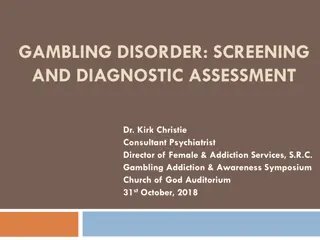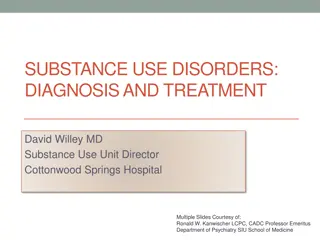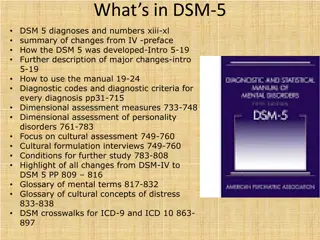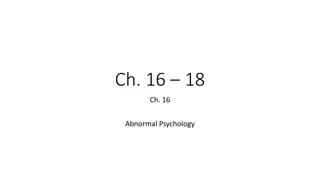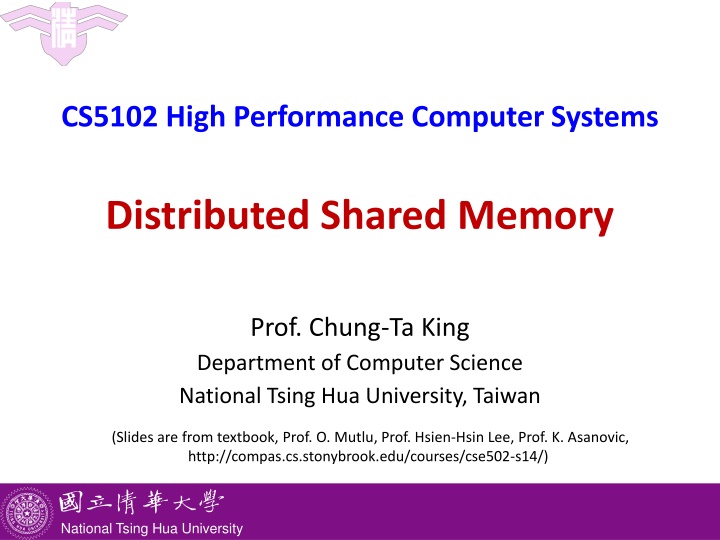
Distributed Shared Memory in High-Performance Computer Systems
Explore concepts like Distributed Shared Memory (DSM), cache coherence, races in DSM, and scalable cache coherence in high-performance computer systems. Learn about centralized and distributed shared memory architectures, synchronization basics, memory consistency models, NUMA architecture, and more.
Download Presentation

Please find below an Image/Link to download the presentation.
The content on the website is provided AS IS for your information and personal use only. It may not be sold, licensed, or shared on other websites without obtaining consent from the author. If you encounter any issues during the download, it is possible that the publisher has removed the file from their server.
You are allowed to download the files provided on this website for personal or commercial use, subject to the condition that they are used lawfully. All files are the property of their respective owners.
The content on the website is provided AS IS for your information and personal use only. It may not be sold, licensed, or shared on other websites without obtaining consent from the author.
E N D
Presentation Transcript
CS5102 High Performance Computer Systems Distributed Shared Memory Prof. Chung-Ta King Department of Computer Science National Tsing Hua University, Taiwan (Slides are from textbook, Prof. O. Mutlu, Prof. Hsien-Hsin Lee, Prof. K. Asanovic, http://compas.cs.stonybrook.edu/courses/cse502-s14/) National Tsing Hua University
Outline Introduction Centralized shared-memory architectures (Sec. 5.2) Distributed shared-memory and directory-based coherence (Sec. 5.4) Synchronization: the basics (Sec. 5.5) Models of memory consistency (Sec. 5.6) 1 National Tsing Hua University
Distributed Shared Memory (DSM) Non-uniform memory access (NUMA) architecture Memory distributed among processors, logically shared All processors can directly access all memory Can use scalable point-to-point interconnection networks no single point of coordination simultaneous communications PE PE PE PE R R R R PE PE PE PE R R R R PE PE PE PE R R R R PE PE PE PE R R R R 2 National Tsing Hua University
Broadcast Can snoopy protocol work for cache coherence on DSM? Write propagation and write serialization? 3 National Tsing Hua University
Races in DSM Consider a DSM with a mesh interconnection NW P Mem st X,0 $ NI PE PE PE PE 1 X R R R R Different caches (PEs) will see different orders of writes Races due to network PE PE 1 PE PE X R R R R PE PE PE 1 PE st X,2 X R R R R PE PE PE PE R R R R 4 National Tsing Hua University
Scalable Cache Coherence We need a mechanism to serialize/order writes Idea: instead of relying on interconnection network to provide serialization, ask a coordinate node directory PE PE PE PE 1 X R R R R PE PE 1 PE PE X R R R R PE PE PE 1 PE X R R R R PE X PE PE PE Directory R R R R 5 National Tsing Hua University
Scalable Cache Coherence Directory: Single point of serialization, one entry for one block An entry tracks cached copies (sharer set) for each block Processors make requests for blocks through directory Directory coordinates invalidation appropriately and communicate only with processors that have copies e.g. P1 asks directory for exclusive copy, directory asks all sharers to invalidate, waits for ACKs, then responds to P1 Communication with directory and copies is through network transactions but is independent of the network, as long as it provides point-to-point communications Directory can be centralized or distributed 6 National Tsing Hua University
Directory-based Cache Coherence Directory tracks who has what Every memory block has an entry in the directory HW overhead for the directory (~ # blocks * # nodes) Can work with UMA SMP, too! P P P P $ $ $ $ Interconnection Network (Centralized) Directory Memory Modified bit Presence bits, one for each node 7 National Tsing Hua University
Directory-based Cache Coherence P P P P P $ $ $ $ $ (Centralized) Directory Interconnection Network C(k) C(k+1) 1 0 0 1 0 0 1 0 0 0 1 1 0 0 0 0 Memory C(k+j) 0 0 1 0 0 0 0 1 1 modified bit for each cache block in memory 1 presence bit for each processor, each cache block in memory 8 National Tsing Hua University
Distributed Directory Cache Coherence Distributed directories track local memory to maintain cache coherence (CC-NUMA) Assumptions: reliable network, FIFO message delivery between any given source-destination pair 9 National Tsing Hua University
Directory Coherence Protocol: Read Miss Every memory block has a home node, where its directory entry resides Home node can be calculated from block address P0Read Z (missed) Pn-1 Pn $ Z $ Z $ Block Z is shared (clean) Home of Z Memory Memory Memory Z 1 1 1 0 0 Go to Home Node Interconnection Network 10 National Tsing Hua University
Directory Coherence Protocol: Read Miss Block Z is dirty ( Modified in Pn-1) Block Z is now clean, Shared by 3 nodes (M S) P0 Pn-1 Pn Read Z (missed) $ Z $ Z $ Memory Memory Memory Z 1 0 0 1 1 0 1 Go to Home node Interconnection Network Ask Owner Reply block Reply to the request node 11 National Tsing Hua University
Directory Coherence Protocol: Write Miss P0 can now write to block Z (I M) P0 Pn-1 Pn Write Z (missed) $ Z X $ Z $ Z X Memory Memory Memory Z 0 0 1 1 1 0 0 1 Go to Home Node Interconnection Network Invalid sharers Ack Reply block 12 National Tsing Hua University
Directory: Basic Operations Follow semantics of snoop-based system (MSI) but with explicit request and reply messages Directory: Receives Read, ReadEx requests from nodes Sends Invalidate messages to sharers if needed Forwards request to memory if needed Replies to requestor and updates sharing state Protocol design is flexible Exact forwarding paths depend on implementation, e.g. directory node or requesting node perform all bookkeeping operations? Must not have race conditions 13 National Tsing Hua University
A Possible 4-hop Implementation L has a cache read miss on a load instruction H is the home node R is the current owner of the block, who has the most up-to-date data for that block, which is in the Modified state State: M Owner: R 1: Read Req 2: Recall Req L H R 4: Read Reply 3: Recall Reply 14 National Tsing Hua University
A Possible 3-hop Implementation L has a cache read miss on a load instruction H is the home node R is the current owner of the block, who has the most up-to-date data for that block, which is in the Modified state State: M Owner: R 1: Read Req 2: Fwd d Read Req L H R 3: Fwd d Read Ack 3: Read Reply 15 National Tsing Hua University
Example Cache States For each block, a home directory maintains its state: Shared: one or more nodes have the block cached, value in memory is up-to-date Modified: exactly one node has a dirty copy of the cache block, value in memory is out-of-date May add transient states to indicate the block is waiting for previous coherence operations to complete Caches in the nodes also need to track the state (e.g. MSI) of the cached blocks Nodes send coherence messages to home directory Home directory only sends messages to nodes that care 16 National Tsing Hua University
Operations in Directory (MSI) For uncached block: Read miss: requesting node is sent the requested data and is made the only sharing node, block is now shared in directory and in requesting node Write miss: the requesting node is sent the requested data and becomes the owner node, block is now modified in directory and in requesting node 17 National Tsing Hua University
Operations in Directory (MSI) For shared block: Read miss: the requesting node is sent the requested data from memory, node is added to sharing set and block is shared in directory and in requesting node Write miss: the requesting node is sent the block, all nodes in the sharing set are sent invalidate messages, sharing set now only contains requesting node, block is now modified in directory and in requesting node 18 National Tsing Hua University
Operations in Directory For modified block: Read miss: the owner is sent a data request message, block becomes shared, owner replies the block to the directory, block written back to memory, sharers set now contains old owner and requestor, block is shared in directory and in requesting node Write miss: the owner is sent an invalidation message, requestor becomes new owner, block remains modified in directory and in requesting node Data write back: the owner replaces and writes back the block, block becomes uncached, sharer set is empty 19 National Tsing Hua University
Read Miss to Uncached or Shared Block CPU Load request at head of CPU->Cache queue. Update cache tag and data and return load data to CPU. 1 9 Load misses in cache. Cache 2 8 ReadReply arrives at cache. Send ReadReq message to directory. 3 Interconnection Network Send ReadReply message with contents of cache block. Message received at directory controller. 7 4 Directory Controller Update directory by setting bit for new processor sharer. 6 DRAM Bank Access state and directory for block. Block s state is S, with 0 or more sharers 5 20 National Tsing Hua University
Write Miss to Read Shared Block CPU CPU CPU CPU Multiple sharers Update cache tag and data, then store data from CPU Store request at head of CPU->Cache queue. 1 12 Invalidate cache block. Send InvRep to directory. Store misses in cache. Cache Cache Cache Cache 2 ExRep arrives at cache InvReq arrives at cache. Send ReadReqX message to directory. 3 11 8 7 Interconnection Network ReadReqX message received at directory controller. InvRep received. Clear down sharer bit. 10When no more sharers, send ExRep to cache. 4 Directory Controller 9 6 message to each sharer. Send one InvReq DRAM Bank Access state and directory for block. Block s state is S, with some set of sharers 5 21 National Tsing Hua University
Directory: Data Structures Directory Presence bits, one for each node Modified bit Key operation to support is set inclusion test False positives are OK: want to know which caches may contain a copy of a block, and spurious invalidations are ignored False positive rate determines performance Most accurate (and expensive): full bit-vector Compressed representation, linked list, Bloom filters are all possible 22 National Tsing Hua University
Issues with Contention Resolution May have concurrent transactions to cache blocks Can have multiple requests in flight to same cache block! Need to escape race conditions by: NACKing requests to busy (pending invalidate) entries Original requestor retries OR, queuing requests and granting in sequence (Or some combination thereof) Fairness Which requestor should be preferred in a conflict? Interconnect network delivery order, and distance, both matter 23 National Tsing Hua University
An Example Race: Writeback and Read L has dirty copy, wants to write back to H R concurrently sends a read to H Races require complex intermediate states Race! Race! Final State: S State: M Owner: L No need to Ack WB and Fwd Rd No need to ack 1: WB Req 2: Read Req 6: L H R 4: 3: Fwd d Read Req 5: Read Reply 24 National Tsing Hua University
Hybrid Snoopy and Directory P P P P $ $ $ $ Memory Memory Memory Memory Snoop bus Snoop bus Directory Directory Interconnection Network Stanford DASH (4 CPUs per cluster, total 16 clusters) Invalidation-based cache coherence Keep one of 3 states of a cache block at its home directory Uncached, shared (unmodified state), dirty 25 National Tsing Hua University
Snoopy vs. Directory Coherence Snoopy + Miss latency (critical path) is short + Global serialization is easy: bus arbitration + Simple: adapt bus-based uniprocessors easily - Relies on broadcast seen by all caches (in same order): single point of serialization (bus): not scalable Directory - Adds miss latency: request dir. mem. - Requires extra storage space to track sharer sets - Protocols and race conditions are more complex + Does not require broadcast to all caches + Exactly as scalable as interconnect and directory storage 26 National Tsing Hua University








